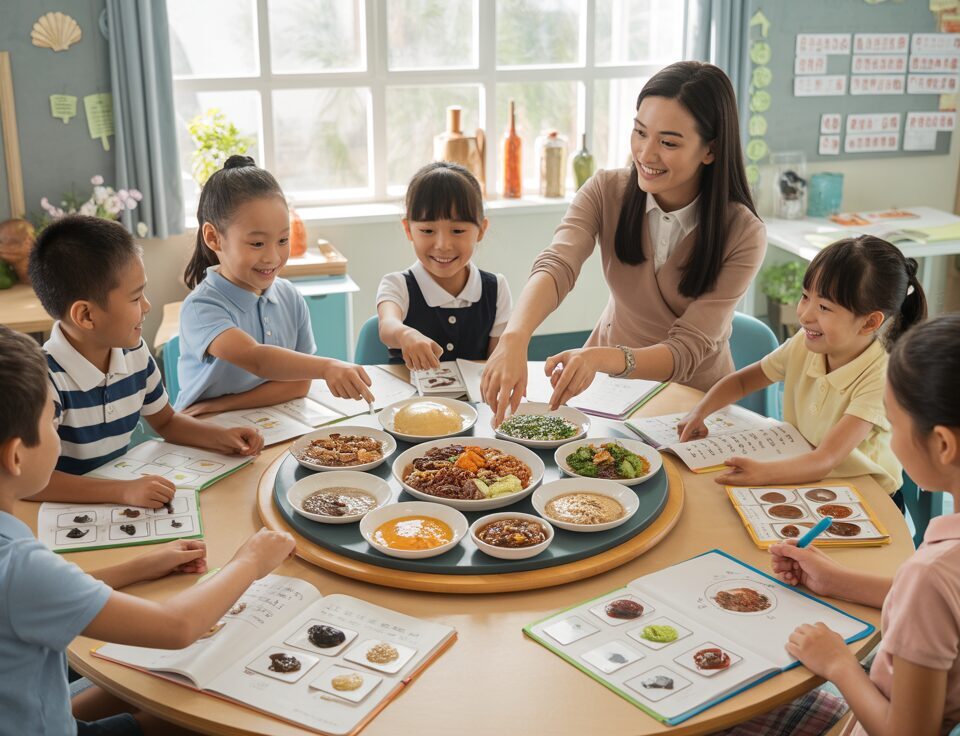
5 Hands-On Magnet Experiments for P3 Students: Making Science Fun and Educational
October 23, 2025
Build a Water-Cycle Model: Step-by-Step Video Guide for Primary School Science
October 25, 2025Table Of Contents
- Introduction: The Value of Plant Diversity Field Trips
- Key Learning Objectives for Plant Diversity Exploration
- Pre-Trip Preparation for Educators and Parents
- Top Singapore Locations for Plant Diversity Field Trips
- Engaging Field Activities to Enhance Learning
- Plant Observation and Documentation Techniques
- Connecting Field Observations to Science Curriculum
- Post-Trip Follow-Up Activities and Extensions
- Conclusion: Nurturing Young Botanists
Complete Plant Diversity Field-Trip Guide for Primary School Students
Imagine the excitement in a child’s eyes as they discover the intricate patterns of a fern frond or the surprising stickiness of a pitcher plant for the first time. Plant diversity field trips offer these transformative moments—opportunities where classroom knowledge blossoms into real-world understanding. At Seashell Academy by Suntown Education Centre, we believe that these experiences form the cornerstone of science education that truly sticks with students long after their primary school years.
While Singapore’s lush botanical landscapes provide the perfect outdoor classroom for exploring plant diversity, organizing an effective field trip requires thoughtful planning to balance educational value with engagement. This comprehensive guide will equip educators and parents with everything needed to create a memorable plant diversity exploration—from preparation and location selection to specific activities and follow-up projects that reinforce learning objectives.
Whether you’re preparing for the Primary 3 plant parts curriculum, exploring adaptations in Primary 5, or reinforcing Primary 6 classification concepts, this guide transforms a simple outdoor excursion into a structured learning adventure that supports academic goals while nurturing a genuine connection with the natural world.
Key Learning Objectives for Plant Diversity Exploration
Before stepping outside the classroom, establishing clear learning objectives helps transform a simple nature walk into a purposeful educational experience. Effective plant diversity field trips should be designed to achieve specific outcomes that align with both curriculum standards and the holistic development of students.
At Seashell Academy by Suntown Education Centre, we structure our outdoor learning experiences around the following key objectives that balance academic knowledge with practical skills:
Scientific Understanding Objectives
Primary students should develop the ability to identify major plant groups (flowering plants, conifers, ferns, mosses) and understand their distinctive characteristics. Through guided observation, students learn to recognize common plant structures including roots, stems, leaves, flowers, fruits, and seeds—connecting classroom diagrams to living specimens.
More advanced objectives include understanding plant adaptations to different environments. For example, how do plants in Singapore’s botanical gardens adapt differently than those in our coastal areas? Students should begin grasping the relationship between plant structures and their functions in survival and reproduction.
Skill Development Objectives
Field trips provide excellent opportunities to develop scientific observation skills using multiple senses. Students practice careful looking, touching (when appropriate), and even smelling to gather data about plants. They learn to document findings through field sketches, simple data collection, and descriptive writing—all foundational skills for future scientific work.
Additionally, students enhance their comparison and classification abilities by sorting plants based on observable characteristics. This reinforces logical thinking and attention to detail that serves them well across all academic subjects.
Attitude and Awareness Objectives
Perhaps most importantly, field trips foster appreciation for biodiversity and its importance to our ecosystem. Students develop awareness of Singapore’s unique plant heritage and understand the need for conservation efforts. This connects their academic learning to real environmental issues, helping them see the relevance of their studies.
The combination of these objectives creates a learning experience that extends far beyond memorizing facts for examinations—it builds a framework for understanding the living world that surrounds us.
Pre-Trip Preparation for Educators and Parents
Thorough preparation transforms a potentially chaotic outing into a smooth, enriching experience. Whether you’re an educator planning for a class or a parent organizing a learning adventure for your child, these preparation steps ensure both educational value and practical success.
Location Research and Logistics
Begin by researching potential locations with diverse plant specimens relevant to your learning objectives. Contact the venue in advance to inquire about educational programs, guided tours, or specific exhibits that align with primary science curriculum. Many Singapore botanical sites offer specially designed educational packages.
Arrange transportation details, create a realistic timeline accounting for travel, exploration, breaks, and unexpected delays. Develop a contingency plan for weather changes, as Singapore’s afternoon showers can interrupt outdoor activities. For larger groups, organize students into smaller teams with assigned adult supervision for better management and more focused learning.
Educational Materials Preparation
Create age-appropriate field guides or observation worksheets that direct attention to relevant plant characteristics. For younger primary students, simple pictorial guides work best, while older students can handle more detailed observation tasks. Prepare any necessary equipment including magnifying glasses, collection bags for fallen specimens (if permitted), measuring tools, notebooks, and pencils.
Develop a pre-trip classroom lesson that introduces key concepts and vocabulary students will encounter. This might include terms like “biodiversity,” “adaptation,” or specific plant structure names. At Seashell Academy, our Programme Philosophy emphasizes building this foundation of knowledge before experiential learning to maximize comprehension.
Practical and Safety Considerations
Prepare a checklist for students including appropriate clothing (long pants to protect from insects and plants), covered shoes, hats, sunscreen, insect repellent, and water bottles. Arrange for first aid supplies and ensure at least one accompanying adult has basic first aid knowledge.
Establish clear behavior expectations and boundaries for the field trip. Create a simple list of rules emphasizing respect for plants (no picking unless specifically permitted), safety procedures, and group staying-together protocols. Share these with students and parents well in advance of the trip.
Lastly, consider any students with special needs or allergies and plan accommodations accordingly. Some students may need alternative observation methods or additional support to fully participate in the learning experience.
Top Singapore Locations for Plant Diversity Field Trips
Singapore offers world-class botanical locations that serve as living laboratories for studying plant diversity. Each venue provides unique educational opportunities focused on different aspects of plant life and adaptations.
Singapore Botanic Gardens
As a UNESCO World Heritage Site, the Singapore Botanic Gardens offers unparalleled plant diversity in a historical setting. The Jacob Ballas Children’s Garden section is specifically designed for educational purposes with interactive exhibits perfect for primary students. Visit the Learning Forest to observe diverse tree species and forest ecology in a structured environment that simulates natural forest layers.
Educational highlights include the Evolution Garden, which chronologically displays plant evolution from prehistoric times to present, making abstract concepts tangible for students. The Ginger Garden showcases over 250 species of this important plant family with distinctive features that demonstrate adaptation and specialization.
Gardens by the Bay
Gardens by the Bay provides exposure to global plant diversity through its controlled environments. The Cloud Forest conservatory demonstrates mountain ecosystem adaptations with plants arranged by elevation, allowing students to observe how plants change with altitude and climate. Meanwhile, the Flower Dome presents plants from Mediterranean and semi-arid regions, highlighting adaptations to water conservation.
The outdoor gardens feature themed collections including the World of Palms and Understorey, perfect for studying plant classification. The Children’s Garden combines learning with play elements that reinforce concepts about water cycles and plant needs.
Sungei Buloh Wetland Reserve
For studying specialized plant adaptations, Sungei Buloh Wetland Reserve offers opportunities to observe mangroves and other wetland vegetation. Students can witness remarkable adaptations such as pneumatophores (breathing roots) and salt excretion mechanisms that allow plants to thrive in challenging environments.
The reserve offers educational guided walks specifically designed for school groups, with educators trained to highlight age-appropriate learning points. The walkways and observation platforms make these unique ecosystems accessible while protecting the sensitive environment.
Pulau Ubin
For a more immersive experience in less manicured settings, Pulau Ubin provides opportunities to observe plants in more natural habitats. The Chek Jawa Wetlands features multiple ecosystems including mangroves, coastal forests, and seagrass habitats, allowing comparison of different plant communities within a small area.
This location is ideal for older primary students who can handle longer walks and more complex ecological concepts. The relative isolation and natural setting create a more adventurous field trip that often leaves lasting impressions on students.
Engaging Field Activities to Enhance Learning
The difference between a forgettable outing and a transformative learning experience often comes down to the activities students engage in during the field trip. These structured exercises convert passive observation into active discovery while reinforcing key learning objectives.
Plant Scavenger Hunts
Create customized scavenger hunt lists appropriate for your students’ age and learning objectives. For Primary 1-3 students, focus on finding basic plant parts or simple characteristics like “a plant with smooth leaves” or “a flower with five petals.” For Primary 4-6 students, increase complexity with challenges like “find evidence of plant adaptation to low light” or “identify three plants from different classification groups.”
Implement the hunt using physical checklists or, for a more engaging experience, create a photo scavenger hunt where teams document their findings with cameras or school tablets. This approach, consistent with Seashell Academy’s gamified interactive lessons, transforms learning into an exciting challenge.
Comparative Observation Stations
Set up temporary observation stations at different points throughout the field trip location. At each station, students focus on comparing specific plant features across different species. For example, one station might examine leaf shapes and edges, while another focuses on stem structures or root systems.
Provide magnifying glasses and simple microscopes where appropriate, along with guided worksheets that prompt specific observations and comparisons. This structured approach helps students notice details they might otherwise overlook while practicing scientific observation techniques.
Plant Adaptation Investigations
Challenge students to become plant detectives by identifying and explaining adaptations they observe. In groups, students select a plant and identify at least three features that help it survive in its environment. For example, waxy coatings on leaves to prevent water loss or bright flowers to attract pollinators.
Students can document these adaptations through labeled sketches and brief explanations, then present their findings to classmates during a mid-trip gathering. This activity develops critical thinking as students connect form and function while practicing scientific communication skills.
Sensory Exploration Activities
Create opportunities for multi-sensory learning through guided sensory activities. Develop a “texture tour” where students feel (when safe and permitted) different plant surfaces and describe them using precise vocabulary. Similarly, a “color gradient” activity challenges students to find and arrange leaves showing a progression of green shades or seasonal color changes.
For locations with fragrant plants, implement a mindful smelling activity where students close their eyes and describe the scents, connecting them to potential ecological functions like attracting pollinators. These sensory experiences create stronger memory associations and deeper appreciation for plant diversity.
Plant Observation and Documentation Techniques
Scientific observation is a skill that improves with guidance and practice. Teaching students proper techniques for observing and recording plant characteristics helps them develop habits that will serve them throughout their academic journey and beyond.
Structured Observation Methods
Introduce the SODAR method (Stop, Observe, Describe, Ask, Record) as a systematic approach to plant observation. First, students stop and take time to observe without rushing. Then they carefully describe what they see using specific terminology. Next, they ask questions about features they notice. Finally, they record their observations and questions.
For younger students, provide observation frames—cardboard frames that help focus attention on specific plant parts. This simple tool helps eliminate distractions and directs observation to particular features like leaf veins or flower parts. For older students, introduce the concept of observing at different scales—from whole plant to individual cells—using appropriate tools like magnifiers.
Scientific Drawing and Field Sketching
Teach basic scientific drawing techniques appropriate for primary students, emphasizing accuracy over artistic skill. Demonstrate how to create labeled diagrams that highlight important features rather than perfect artistic renderings. Show examples of good scientific illustrations that clearly communicate plant structures.
Provide structured drawing templates with spaces for measurements, notes, and detail enlargements. For Primary 5-6 students, introduce scale drawing concepts where they indicate the actual size relationship in their sketches. This mathematical integration supports our cross-disciplinary approach at Seashell Academy’s Mathematics Programme.
Digital Documentation Options
When appropriate, incorporate digital tools like tablets or smartphones for photo documentation. Teach students to take multiple angles of the same plant and to include reference objects for scale. Apps specifically designed for plant identification can be introduced to older primary students as supplementary tools.
Create digital field journals where students combine photos with text observations in a multimedia record. This approach particularly engages students who are more technologically inclined while teaching digital organization skills relevant to modern scientific practice.
Collaborative Documentation Strategies
Implement pair or small group documentation where students take on specialized roles—such as sketcher, measurer, describer, and recorder—then combine their observations into a more complete record than any individual could create alone. This mirrors real scientific fieldwork practices while developing teamwork skills.
Create collective class field guides by assigning each group different plants to document thoroughly. After the trip, compile these into a complete reference that represents the combined knowledge of the class. This collaborative approach produces a valuable resource while giving students a sense of contribution to a larger project.
Connecting Field Observations to Science Curriculum
The true educational value of a plant diversity field trip emerges when students can connect their hands-on observations to the formal science curriculum. This connection transforms isolated experiences into coherent knowledge that supports classroom learning and examination preparation.
Primary 3-4 Curriculum Connections
For Primary 3-4 students studying plant parts and functions, field observations can directly illustrate textbook concepts. During the trip, prompt students to identify the major plant organs (roots, stems, leaves, flowers) on various plants and discuss their functions. Guide them to notice variations in these structures across different species.
Connect observations to topics like plant growth requirements by discussing how the plants in different settings receive their needs for water, light, and nutrients. For example, at Gardens by the Bay, the controlled environments provide clear examples of how plants adapt to different climate conditions.
Primary 5-6 Curriculum Connections
Older primary students studying plant reproduction can observe different flower structures and fruit types during the field trip. Guide discussions about how these structures facilitate pollination and seed dispersal. At locations like Singapore Botanic Gardens, the diversity of reproductive strategies becomes readily apparent.
For Primary 6 students preparing for PSLE Science, field observations provide concrete examples of classification, adaptation, and interdependence concepts that frequently appear in examinations. Create explicit connections between field observations and potential examination questions to help students recognize the practical applications of their textbook knowledge.
Cross-Disciplinary Learning Opportunities
Beyond science, plant diversity field trips offer natural connections to other subjects. Incorporate language arts by having students write descriptive paragraphs about their observations or create poems inspired by the plants they encounter. This aligns with Seashell Academy’s holistic educational approach that sees knowledge as interconnected rather than compartmentalized.
Mathematics integration occurs naturally through measurement activities, data collection, and pattern recognition in plant structures. Art connections emerge through scientific drawing and color observation. These cross-disciplinary links help students develop a more integrated understanding of knowledge while appealing to different learning preferences.
Post-Trip Follow-Up Activities and Extensions
The learning potential of a field trip extends well beyond the actual visit. Thoughtfully designed follow-up activities consolidate knowledge, address misconceptions, and extend learning in new directions. These activities transform a single day’s experience into weeks of educational value.
Classroom Reflection and Discussion
Schedule a structured reflection session soon after the field trip where students share their most significant observations and questions. Create a collective mind map of plant diversity concepts encountered during the trip, helping students organize their experiences into coherent knowledge frameworks. This visual organization technique mirrors the mind-mapping approaches we employ at Seashell Academy.
Facilitate small group discussions where students compare observations and resolve any misconceptions that may have developed. These peer conversations allow students to verbalize their understanding while exposing them to different perspectives. The teacher’s role becomes that of a guide who clarifies and corrects as needed rather than simply delivering information.
Creative Extension Projects
Younger primary students can create “Plant Passport” booklets where they develop profiles for plants they observed, including illustrations, basic facts, and interesting features. This creative project reinforces observation skills while practicing information organization in an age-appropriate format.
Older students might design plant adaptation dioramas or models showing how specific plants have structural adaptations for their environments. These three-dimensional projects challenge students to apply their understanding of form and function while creating tangible representations of abstract concepts.
Scientific Investigation Extensions
For continued learning, establish classroom growing stations where students can cultivate specimens collected during the field trip (if permitted) or similar species. These long-term observations allow students to witness growth patterns and life cycles firsthand, extending the one-day experience into ongoing investigation.
Challenge Primary 5-6 students to design simple experiments based on questions that arose during the field trip. For example, if they observed different leaf shapes in sun versus shade, they might design an investigation about how light affects plant growth. These student-directed inquiries develop scientific thinking while addressing genuine curiosity.
Assessment and Evaluation Opportunities
Create authentic assessment tasks that evaluate learning from the field trip experience. Rather than traditional tests, consider performance assessments where students demonstrate skills like plant identification, scientific drawing, or explaining adaptations. These assessments measure both content knowledge and process skills.
For older students preparing for Primary 4 or Primary 5 examinations, develop practice questions that utilize the field trip context. For example, “Based on our observations at Sungei Buloh, explain how mangrove trees are adapted to their environment.” These connections help students see the relevance of their experiences to academic expectations.
Conclusion: Nurturing Young Botanists
A well-executed plant diversity field trip represents far more than a day away from the classroom—it’s an investment in creating meaningful connections between academic concepts and the living world. When students touch the sticky surface of a pitcher plant or marvel at the geometric precision of a fern’s leaflets, they develop not just scientific understanding but also emotional connections to the natural world that textbooks alone cannot provide.
At Seashell Academy by Suntown Education Centre, we recognize that these formative experiences contribute significantly to a child’s holistic development. Our approach to education has always emphasized the importance of balancing academic rigor with emotional engagement—creating learners who not only know scientific facts but also care about their application and implications.
The diverse botanical settings of Singapore offer unparalleled opportunities for these learning adventures. By following the preparation steps, implementing engaging activities, and conducting thoughtful follow-up work outlined in this guide, educators and parents can transform simple outings into powerful learning experiences that support curriculum objectives while nurturing a genuine fascination with plant life.
Remember that the true measure of a successful field trip isn’t just what students can recall for an examination, but how it shapes their relationship with learning itself. When a child later points excitedly at a plant and recalls its special adaptations or wonders aloud about its classification, you’ll know that the seeds of scientific curiosity have taken root—perhaps the most valuable outcome of all.
Ready to Nurture Your Child’s Scientific Curiosity?
At Seashell Academy by Suntown Education Centre, we incorporate these experiential learning approaches into our comprehensive science education programs. Our experienced MOE-trained educators are passionate about bringing science concepts to life through a perfect balance of academic rigor and engaging, hands-on experiences.
Want to learn more about how our unique Seashell Method can help your child develop both strong scientific understanding and a genuine love of learning? Contact us today to schedule a consultation or learn more about our primary school programs.





